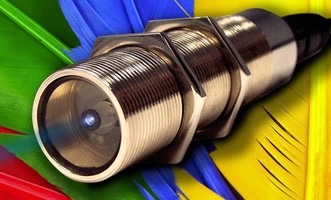Vision and Imaging Sensors / Detectors
Color Sensor combines discrete and RGB analog outputs.
Press Release Summary:

ColorMax(TM)-1000 RGB outputs raw RGB readings as analog signals representing intensity of each color component. Signals are sent to PLCs containing algorithms to evaluate data, enabling operators to see intensity of individual RGB readings. In addition, 4 discrete outputs signals indicate match/no match condition for up to 4 colors programmed into memory. Available in M30 threaded enclosure, units offer detection range of 30-100 mm and 5 kHz sample speed.
Original Press Release:
EMX Announces First Color Sensor That Combines Discrete and RGB Analog Outputs
New Sensor Replaces Sophisticated Color Sensing Systems Cleveland - March 3, 2006 - EMX Industries, a manufacturer of sensors for automation, introduces ColorMax(TM)-1000 RGB color sensor with 4 discrete outputs plus RGB analog outputs. The combination of discrete and analog outputs in one sensor provides more intelligent control over manufacturing processes requiring color recognition. Unlike any other color sensor, the ColorMax-1000 RGB outputs raw RGB readings as analog signals representing the intensity of each color component. The raw RGB signals can be input to programmable logic controllers containing specific algorithms to evaluate the data. Enabling operators to see the intensity of individual RGB readings allows them to adjust a process quickly to maintain color consistency. EMX's new color sensor has individually programmable tolerances for each component (RGB) that makes up a specific color. The tolerances are adjustable on a channel-by-channel basis, which enables finer control of processes. For example, an operator can determine that the critical reading for matching an exact color in an operation is the level of red, in which case the acceptable range for red could be set more narrowly than the ranges for blue and green. Analog signals are better suited for communications because digital readings would exceed the throughput limitations of typical serial protocols. Enabling operators to see the intensity of individual RGB readings allows them to adjust a process quickly to keep it running properly. In addition to the analog signals, the ColorMax-1000 RGB color sensor has four discrete outputs that operate as a traditional color sensor. The discrete signals indicate a match/ no match condition for up to four colors programmed into memory. Replaces Sophisticated Color Systems ColorMax-1000 RGB sensors can be used in applications that now require sophisticated color-sensing equipment. Color variations detected by the sensor can be used as input by an automated system to take corrective action. With this approach, the controller can make minor in-process adjustments without reprogramming or operator intervention. In addition, instead of the sensor making the match decision, a controller now can perform this function. For the first time, process engineers have the option of developing their own algorithms for color control. Using color-intensity data from the sensor, a controller can store and make matching decisions on a virtually unlimited number of colors. Applications that can benefit from in-process monitoring of color quality include manufacturing products with stringent color specifications such as textile manufacturing, printing operations, plastic injection molding, and painting/coating systems. Discrete applications include assembly, printing, and packaging lines that have a need to detect components, verify steps in the manufacturing process, and match different components by color. M30 Enclosure Simplifies Installation and Adjustment Like other sensors in the ColorMax product family, the ColorMax-1000 RGB sensor is available in an M30 threaded enclosure, familiar to any engineer who has worked with proximity sensors. This unique configuration greatly simplifies installation. Distance can be adjusted up to three inches simply by turning the sensor. In contrast, all other color sensors require users to install a special mounting bracket. The detection range for ColorMax-1000 sensors is 30 to100 mm. At recommended operating distance (50 mm) the beam diameter is a tiny 4 or 8 mm spot - enabling engineers to pinpoint readings and minimize background color interference. High Resolution and Repeatability, Fast Sampling By employing low-noise technology in the ColorMax-1000 sensor family, EMX reduced color variation to 0.5% - the best specification in the industry. High resolution is especially important for detecting color variations at high speeds. In addition, the 5-kHz sample speed of ColorMax-1000 sensors is two to five times faster than that of other color sensors - fast enough to keep up with demanding high-speed manufacturing processes. Secure Operation For operational security, a supervisor can lock the unit's settings, either remotely or directly on the unit. This feature prevents operators from changing sensor settings to avoid having to report manufacturing quality issues. Most color sensors do not offer this level of assurance. Ability to Ignore Luster Because color sensing is based on a measurement of reflected light, color sensors can be 'fooled' by the luster of shiny surfaces. ColorMax-1000 sensors overcome this challenge by using sophisticated software algorithms that ignore luster. Few color sensors offer this capability. Fast and Convenient Integration ColorMax-1000 sensors are the only color sensors that can be programmed via a PC, simplifying sensor installation. If additional sensors are added or if a sensor is replaced, the technician can copy and paste the color profiles stored in the PC software. Color profiles will not be lost if a sensor stops working. In addition, ColorMax-1000 sensors are the only color sensors that automatically detect the PLC connection for PNP or NPN configuration during setup. This feature simplifies ordering and reduces stocking requirements by 75%, because users and distributors no longer need to stock different versions of the sensor. Unlike some competing sensors, the ColorMax-1000 sensor line includes both auto-teach and manual calibration. This makes the sensors easy for low-skill operators to calibrate; yet it provides the ability to be finely tuned. LED indicators for power, programming, and detection functions aid in setup and troubleshooting. ColorMax-1000 sensors feature an IP67-rated nickel-plated brass housing suitable for a wide range of manufacturing environments, plus short-circuit, over-current, and reverse polarity protection. Connections are made via a circular 12-pin connector. Price and Availability The ColorMax-1000 RGB color sensor from EMX is available three weeks ARO. List price for one sensor is less than $2000, with discounts available for quantity orders. To request a datasheet on the ColorMax-1000 RGB sensor, or to talk to an applications engineer about how color sensors can reduce manufacturing costs and improve processes, call EMX at 800-426-9912, send email to salessupport@emxinc.com, or visit the EMX web site at www.emxinc.com.




